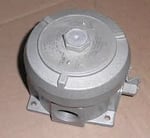My last post about superficial improvement may have implied that the condition is limited to organizations with deep enough pockets to buy pricey automation. There are also plenty of opportunities for superficial improvement in small shops. Here’s an example of a manual assembly waste that took years to eliminate:
The product was housed in a die-cast cylindrical enclosure with a threaded cover. Design requirements stipulated eleven threads, which translated to many turns, a repetitive motion problem at several points on the factory floor.
Compounding this problem was the fact that covers were not truly interchangeable between enclosure bases, requiring care to avoid mis-matches and jamming. (Separating jammed covers from bases was not easy.) The enclosure was sole-sourced with a die-caster who claimed the problem was ‘unavoidable’ and could be managed only by sorting and carefully matching the threads of cover and base. The possibility to retool the casting at a more responsive supplier was, at least on paper, not viable.
As is often the case with these unavoidable problems, production sucked it up and sought workarounds.
First, an application of lubricant to the cover reduced the amount of torque to affix or remove it; but the motion waste remained. Then an assembly employee submitted an idea to use a low speed nut driver to screw and unscrew the cover. This improvement transferred the motion from person to machine – superficial – but at least eliminated the manual strain. Next, a further superficial improvement was made to mount the nut driver to the bench, eliminating the hand-as-holding- fixture problem.
Adding insult to injury, the cover was removed and re-affixed four different times as it traveled through a functionally organized factory, requiring multiple iterations of superficial improvement. Repetitive human motion was replaced by the repetitive machine motion. From subassembly to final assembly to test and finally to labeling and packing, the cover was screwed off and on, off and on.
After a few years on the Lean journey, the four separate functions merged to a single cell, the first ‘real’ improvement, which reduced the motion waste by about 80%. As a result of one-by-one production with operations in close proximity, operators could maintain visual control of cover and enclosure without worrying about mixing parts – fewer off-and-on’s. But workers were still not satisfied.
“Why doesn’t the supplier just ship us covers and enclosures separately?” an employee asked. “The supplier screws the cover on to ship to us, then we unscrew it and rescrew it to ship to the customer, and then the first thing the customer does is unscrew it again to wire the product!”
“I agree,” I said, “it’s maddening. But we’ve done what we can do for now, and we’ll keep working on it.”
Some time later, when the old dies needed replacing, interchangeability of cover and base became a “must have” feature, a little challenging as it turned out, but absolutely avoidable. Bases were delivered to the beginning of the cell, and covers to the end. Only once was the cover now screwed on, the last step before packing. We rationalized this to be work, because customers had asked that the cover be affixed before shipment.
Sometimes seemingly simple problems take years to remedy, but if we persist, we prevail. After multiple years, this particular repetitive madness was cured.
Do you have an ‘unavoidable’ problem that you're working on? Or maybe a superficial improvement? Please share a story.
O.L.D.

